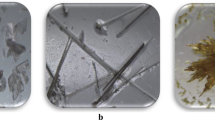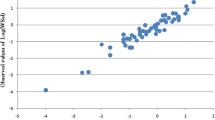Abstract
Chemical structure parameters have been calculated by the RHF/6-31G** ab initio method for model polycyclic molecular fragments of petroleum asphaltenes. A nonplanar character of the planes with the dihedral angle α between the planes of the aromatic and naphthenic moieties in the range of 154°–164° has been revealed for these entities. It has been shown that the stacking of polycyclic structures is facilitated by the possibility of donor-acceptor interactions.
Similar content being viewed by others
References
S. R. Sergienko, B. A. Taimova, and E. I. Talalaev, High-Molecular-Mass Nonhydrocarbon Petroleum Compounds (Nauka, Moscow, 1979) [in Russian].
Yu. V. Pokonova, Chemistry of High-Molecular-Mass Petroleum Compounds (LGU, Leningrad, 1980) [in Russian].
O. A. Beiko, A. K. Golovko, L. V. Gorbunova, et al., Chemical Composition of West Siberian Crude Oils (Nauka, Novosibirsk, 1988) [in Russian].
F. G. Unger and L. N. Andreeva, Fundamental Aspects of Petroleum Chemistry: Nature of Resins and Asphaltenes (Nauka, Novosibirsk, 1995) [in Russian].
K. Akbarzade, A. Hammani, A. Kharat, et al., Neftegaz. Obozren. 19(2) 28 (2007).
M. W. Boduszynski, Chemistry of Asphaltenes (American Chemical Society, Washington, 1981).
R. P. Rodgers and A. G. Marshall, Petroleomics. Asphaltenes. Heavy Oils and Petroleomics (New York, 2007).
I. Merdrignac, G. Desmazieres, P. Terrie, et al., in Proceedings of International Conference on Heavy Organics Deposition, Mexico, (2004), p. 265.
B. Martmez-Haya, M. D. Lobato, M. Pedrosa, and S. Lago, J. Mass Spectrom., No. 7, 960 (2006).
H. Groenzin and O. Mullins, Energy Fuels 14, 677 (2000).
J. Dickie and T. Yen, Anal. Chem. 39, 1847 (1967).
X. Tan, H. Fenniri, and M. R. Gray, Energy Fuels 22, 715 (2008).
S. R. Bagheri, A. Bazyleva, M. R. Gray, et al., Energy Fuels 24, 4327 (2010).
Yu. M. Ganeeva, T. N. Yusupova, and G. V. Romanov, Dokl. Akad. Nauk 5, 629 (2009).
Kh. Murgich, Physicochemical Properties of Disperse Systems and Oil-and-Gas Technologies, Ed. by R. Z. Safieva and R. Z. Syunyaev (Inst. Komp;yuternykh Tekhnologii, Izhevsk, 2007) [in Russian].
F. Jensen, Introduction to Computational Chemistry (Wiley, New York, 2007).
Author information
Authors and Affiliations
Corresponding author
Additional information
Original Russian Text © S.A. Shutkova, M.Yu. Dolomatov, S.V. Dezortsev, 2012, published in Neftekhimiya, 2012, Vol. 52, No. 4, pp. 299–303.
Rights and permissions
About this article
Cite this article
Shutkova, S.A., Dolomatov, M.Y. & Dezortsev, S.V. Structural and chemical characteristics of model molecular fragments of petroleum asphaltenes. Pet. Chem. 52, 267–271 (2012). https://doi.org/10.1134/S0965544112040081
Received:
Published:
Issue Date:
DOI: https://doi.org/10.1134/S0965544112040081




